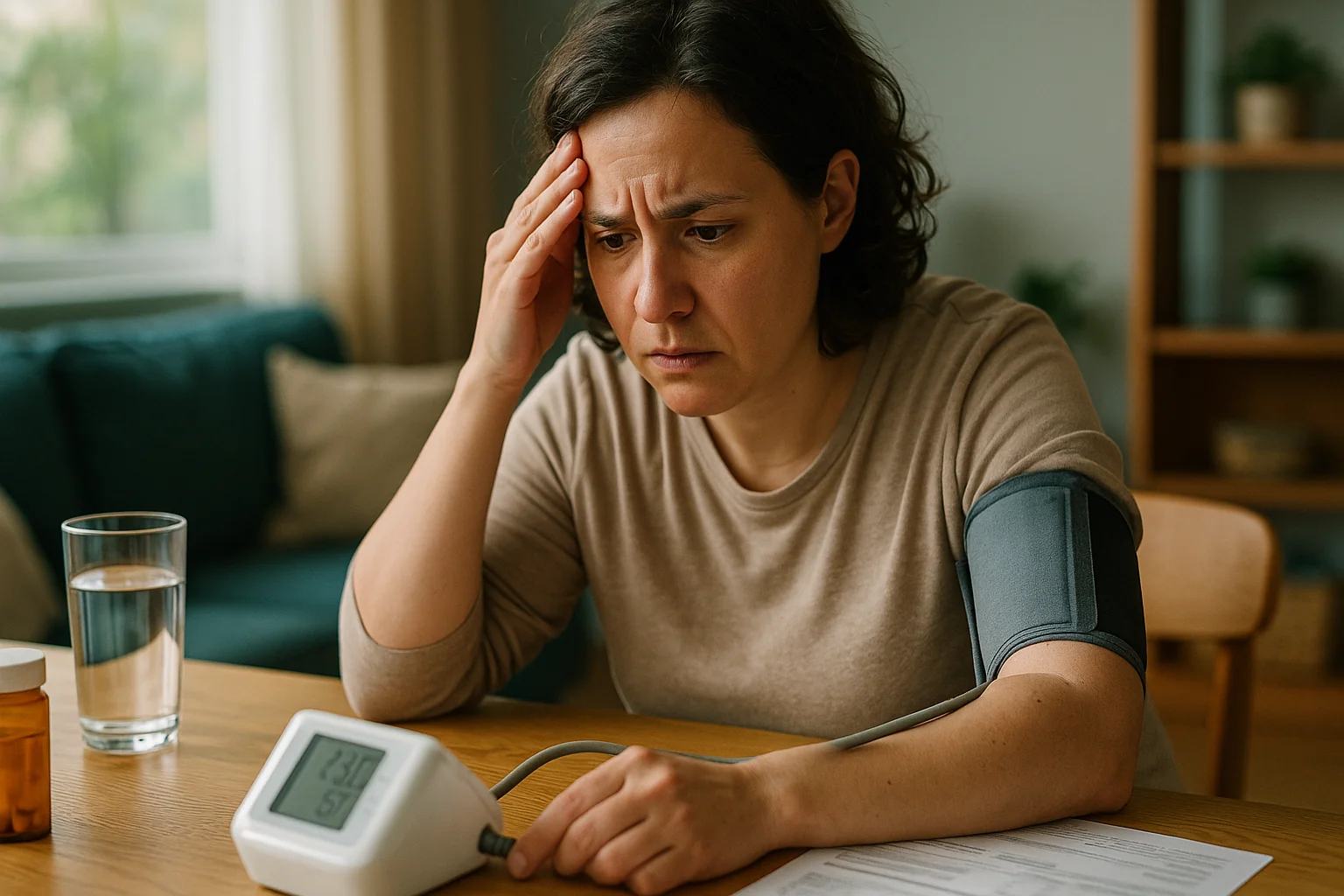A 2 minute assessment to get a personalized mental health or alcohol recovery plan.
Heavy drinking doubles chronic kidney disease risk, and even moderate use raises blood pressure, one of the leading causes of kidney failure, with evidence showing that less alcohol is better for long-term kidney health.
What You'll Discover:
- How alcohol interferes with kidney function through dehydration, blood pressure, and electrolyte balance
- Why heavy drinking doubles chronic kidney disease risk according to the National Kidney Foundation
- The link between binge drinking and acute kidney injury from dehydration and rhabdomyolysis
- Mixed evidence on moderate drinking and why blood pressure control matters more than observational studies
- Practical strategies to protect your kidneys if you choose to drink
- Evidence-based treatment options including therapy and naltrexone when cutting back is difficult
Your kidneys regulate fluid, electrolytes, acid-base balance, blood pressure, and waste removal, including alcohol byproducts. Heavy, regular drinking can double the risk of chronic kidney disease (CKD) and worsens dehydration and electrolyte balance, especially during binges.
The connection often runs through blood pressure. Alcohol raises the risk of hypertension in a near-linear, dose-dependent way, and hypertension is one of the leading causes of CKD and kidney failure worldwide. Cutting alcohol lowers blood pressure and long-term kidney risk.
All that said, if you've been drinking heavily, do not stop suddenly without medical guidance. Alcohol withdrawal can be dangerous and sometimes requires supervised care.
With that in mind, here's exactly how alcohol affects your kidneys, what the evidence shows about risk, and how to protect kidney health whether you drink or not.
How your kidneys work and how alcohol gets in the way
Your kidneys regulate fluid, electrolytes (sodium, potassium), acid-base balance, blood pressure, and remove metabolic waste, including alcohol byproducts. Alcohol interferes along several axes.
Diuresis and dehydration - Even modest alcohol doses increase urine output by suppressing vasopressin (ADH), the hormone that tells kidneys to conserve water. More urine dehydrates you, concentrates the blood, and stresses the kidneys' fine-tuned filtration.
Blood pressure - Alcohol consumption shows a near-linear association with hypertension (risk ratios step up moving from about 24 g/day to 36 and 48 g/day). Hypertension damages glomeruli over years, leading to CKD. Cutting alcohol helps lower BP.
Electrolyte and acid-base effects - Heavy or prolonged use can disturb sodium, potassium, magnesium, and phosphate balance, sometimes dramatically during binges or poor nutrition. Extreme patterns like "beer potomania" (lots of low-solute beer plus low dietary solute) trigger dangerous hyponatremia.
Inflammation and toxins - Alcohol can increase systemic inflammation and, when combined with heat, exertion, or immobilization, promote muscle breakdown (rhabdomyolysis), releasing myoglobin that clogs tubules and can cause acute kidney injury (AKI).
Kidney-liver cross-talk - In advanced alcohol-related cirrhosis, the kidney's blood flow distribution and filtration fall precipitously (hepatorenal syndrome), with no structural kidney damage early on but high mortality if untreated.
CKD 101 - what kidney disease means
Chronic kidney disease is defined as abnormal kidney structure or function for 3 or more months with health implications, classified by cause, eGFR stage (G1 to G5), and albuminuria (A1 to A3), the CGA system used by KDIGO and clinicians worldwide. Persistent albumin in urine (A2/A3) is an early alarm bell even when eGFR looks "normal."
High blood pressure, diabetes, and cardiovascular disease are the main CKD drivers. Alcohol influences all three, particularly BP, which is why the alcohol-kidney link often runs indirectly through hypertension and metabolic stress. KDIGO's 2021/2024 guidance emphasizes tight BP control (systolic BP less than 120 mm Hg in many adults with CKD when tolerated) as kidney protection, another reason to reconsider alcohol.
What the evidence says - alcohol and kidney risk
Heavy use consistently harmful - The National Kidney Foundation highlights that heavy drinking doubles CKD risk, and binge patterns add dehydration and electrolyte swings that can precipitate AKI. Acute and chronic alcohol exposure impairs kidney function, especially when liver disease is present. In experimental and clinical contexts, alcohol exposure increases AKI severity after a kidney insult, pointing to reduced resilience.
Binge drinking and AKI - under-recognized risk - Binge episodes (rapid high-dose intake) trigger diuresis, dehydration, and can set up rhabdomyolysis (from prolonged immobilization, seizures, or exertion), leading to myoglobin-mediated AKI, a medical emergency. Case series and reviews repeatedly document alcohol-related rhabdomyolysis with subsequent dialysis-requiring AKI, a reminder that one bad night can have long-lasting renal consequences.
Light-to-moderate use - mixed observational signals (interpret cautiously) - Some cohorts report less CKD among light/moderate drinkers than abstainers; others find a U-shaped pattern. Proposed explanations include healthy-user bias (moderate drinkers also exercise more, have better diet and healthcare access) and misclassification of "sick quitters." Important nuance: even if some kidney endpoints look neutral or slightly better at low doses, alcohol still raises BP in a near-linear fashion and increases overall health risks (injury, cancer, sleep disruption). For kidney protection, focus on blood pressure and hydration, which typically improve as alcohol decreases.
Stones and other kidney conditions - On kidney stones, recent analyses are inconclusive; one 2023 study found no significant association, while newer population data in 2024 suggested a lower stone risk in "drinkers." Differences in beverage, diet, and measurement likely explain discrepancies. Regardless, alcohol is not a treatment for stones and can worsen dehydration, a key stone driver.
Special scenarios where alcohol hits kidneys hard
Heat, exertion, and parties - Warm environments plus exertion plus drinking equals a perfect storm for dehydration and rhabdomyolysis. If alcohol is on board, muscle breakdown risks rise and kidneys face a surge of myoglobin, which can obstruct tubules and crash eGFR. Dark urine, severe muscle pain, profound weakness require urgent care.
Low-solute diets and beer potomania - Heavy beer intake with low dietary protein/solute can cause profound hyponatremia (dangerously low sodium). Symptoms range from fatigue and confusion to seizures. Correction must be careful to avoid osmotic demyelination. Prevention: adequate dietary solute and avoid binges.
Alcohol-related liver disease and hepatorenal syndrome - In cirrhosis, systemic hemodynamics shift, kidney perfusion drops, and hepatorenal syndrome can develop without intrinsic kidney damage at first. HRS is life-threatening and underscores how alcohol harms kidneys through the liver. Sustained abstinence reduces progression risk.
How to think about safe drinking if you care about your kidneys
There is no universal safe dose. Risk depends on your blood pressure, hydration, comorbidities (diabetes, liver disease), medications, and pattern (binges versus sips). Several patient-facing kidney organizations advise that if you drink, do so sparingly, avoid binges, and stay within low-risk guidelines. Always ask your clinician if you have CKD or take medicines affected by alcohol.
Kidney-protective lens - If you have hypertension, diabetes, albuminuria, or established CKD, reducing alcohol is a direct kidney-protective move because it helps BP control, preserves sleep, and improves hydration patterns. Less is better, and many people benefit from alcohol-free days or full abstinence. If you're generally healthy and choose to drink, avoid binge patterns, hydrate, and keep weekly totals low, knowing that even at low doses alcohol nudges BP upward and adds renal stress during illness, heat, or exertion.
Practical playbook - protect your kidneys if you drink at all
Pressure and pattern first - Know your BP. Home BP monitoring (validated cuff) catches alcohol-related spikes you might miss at clinic visits. Reducing alcohol can reduce systolic BP; improvements compound with diet, activity, and sleep. Stop the spikes. Avoid binges, they drive dehydration, electrolyte derangements, and AKI. If you do drink, 1 drink or less per hour, cap at 1 to 2 drinks, and finish 3 to 4 hours or more before bed (sleep fragmentation also raises BP).
Hydrate and add solute - Pair each alcoholic drink with water; target light-yellow urine by day's end. Eat protein plus electrolytes (a normal mixed meal) when drinking to avoid low-solute hyponatremia. Beer-only plus poor diet is a known path to beer potomania.
Heat, exercise, and illness hacks - Do not combine alcohol with long, hot endurance sessions; if you do exercise socially, separate the two by several hours and rehydrate first. During fever, vomiting/diarrhea, or new meds (diuretics, ACE inhibitors), avoid alcohol; kidneys are extra vulnerable in these states.
Medicines and labs - Alcohol interacts with BP meds, diuretics, and diabetes meds. Review your list with your clinician and ask how alcohol affects creatinine, eGFR, and albumin-creatinine ratio (ACR). KDIGO staging relies on these.
When to seek urgent care
Signs of AKI: very dark/low urine, swelling, sudden weight gain, shortness of breath, or confusion after a heavy night/heat/exertion. Rhabdomyolysis red flags: severe muscle pain/weakness, cola-colored urine, fever, or prolonged immobilization after intoxication. Early IV fluids save nephrons. Severe hyponatremia symptoms: confusion, seizures, severe headache after prolonged beer intake and poor diet, beer potomania is a medical emergency.
If cutting back is hard - evidence-based help
Behavior change drives kidney protection: fewer drinking days, ending binges, earlier cut-offs, better sleep. If those steps aren't sticking, talk with your clinician about a structured plan.
Counseling - Motivational interviewing and cognitive-behavioral therapy (CBT) map triggers (Thursday client dinners, travel), build refusal scripts, and repair sleep routines that otherwise push drinking.
Medication option (when appropriate): naltrexone oral tablets - For many adults with Alcohol Use Disorder (AUD) or recurrent heavy episodes, naltrexone oral tablets reduce heavy-drinking days and craving, especially alongside counseling. Clinicians check for contraindications (notably current opioid use/dependence, acute hepatitis/liver failure), review liver tests, and align dosing (commonly 50 mg/day) to your goals. By cutting heavy days, you lower BP, dehydration, and AKI risk, all kidney-protective.
Safety note: If you've been drinking heavily, do not stop suddenly without medical advice. Alcohol withdrawal can be dangerous and sometimes requires supervised care. Your clinician can time the change safely.
Frequently asked questions
Can moderate drinking ever help kidney health? - Some cohorts suggest lower CKD incidence among light/moderate drinkers, but these studies are vulnerable to confounding (moderate drinkers tend to have healthier lifestyles). Meanwhile, alcohol raises BP in a graded fashion, a key CKD driver. In practice, kidney-protective choices usually mean less alcohol, not more.
I have stage 2 to 3 CKD - can I drink at all? - Ask your nephrology or primary-care team. Several kidney organizations advise that some people with CKD may drink sparingly if BP, electrolytes, and volume status are controlled, but binges are a hard no. Fluid and potassium limits (for some CKD patients) may also influence beverage choice.
Does alcohol cause kidney stones? - Evidence is mixed; some analyses show no association, others report lower stone risk among "drinkers." Regardless, alcohol does not prevent or treat stones and may worsen dehydration, a primary stone risk. Focus on water intake and diet set by your clinician.
Is wine safer than spirits or beer for my kidneys? - For kidneys, the dose and pattern dominate. All alcohol increases diuresis and BP. Beer carries a beer potomania hazard if paired with low solute intake; spirits can concentrate dose quickly; wine shares the BP and sleep effects. Avoid binges, keep totals low, hydrate, and protect sleep.
If I reduce alcohol, how soon might my kidneys benefit? - BP reductions can appear within weeks, which is kidney-protective long-term. You may notice fewer nocturnal awakenings (less diuresis) and better hydration quickly. Your team will track eGFR and ACR over months.
What labs should I watch? - Ask about serum creatinine/eGFR, urine albumin-creatinine ratio, electrolytes (sodium, potassium), and BP trends. These map to KDIGO staging and guide prevention.
Ready to understand where you stand?
Not sure if your drinking pattern puts your kidneys at risk? Our quick, confidential alcohol assessment gives you personalized guidance you can share with your clinician, plus safer next steps aligned to your goals.




